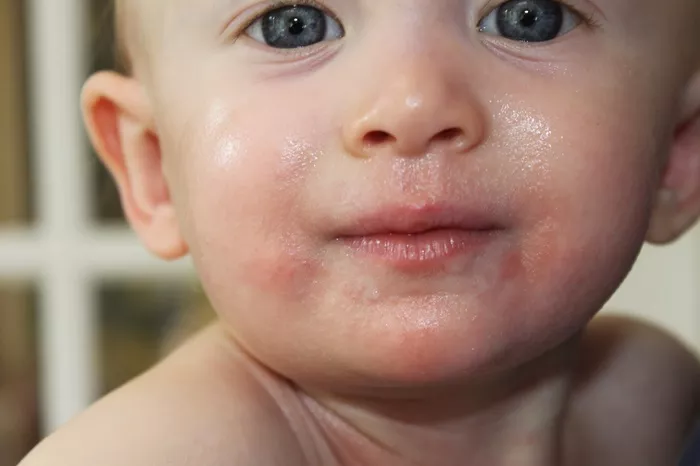Milk rash, often observed in infants and young children, is a common dermatological condition that can cause concern for parents and caregivers. Understanding milk rash, its causes, symptoms, treatment, and prevention is essential for effective management and care. This comprehensive article explores milk rash in detail, providing valuable insights for parents, caregivers, and healthcare professionals.
Understanding Milk Rash
Definition
Milk rash, also known as atopic dermatitis or infantile eczema, is a skin condition characterized by red, itchy, and sometimes scaly patches on a baby’s skin. While the name suggests a link to milk, the rash is not directly caused by milk consumption but may be exacerbated by certain factors related to feeding and environment.
Common Misconceptions
One common misconception is that milk rash is caused by an allergy to milk. While food allergies can contribute to skin rashes, milk rash is typically more related to skin sensitivity and environmental factors rather than a direct allergic reaction to milk.
Causes of Milk Rash
Skin Sensitivity
Infants have delicate, sensitive skin that can easily become irritated. Milk rash often occurs due to the skin’s reaction to various irritants, including:
Saliva: Drooling, especially during teething, can irritate the skin around the mouth and chin, leading to rashes.
Spit-Up: Frequent spitting up of milk can cause irritation on the face and neck.
Environmental Factors: Heat, humidity, and exposure to certain fabrics or detergents can also contribute to skin irritation.
Allergens and Irritants
While not the primary cause, food allergens can exacerbate existing skin conditions. In some cases, a baby may have an underlying sensitivity to certain foods, including dairy, that can worsen skin rashes. Other common irritants include:
Soaps and Lotions: Harsh soaps, shampoos, and lotions can strip the skin of natural oils, leading to dryness and irritation.
Fabric Softener: Certain chemicals in fabric softeners can irritate sensitive skin.
Detergents: Laundry detergents with strong fragrances or harsh chemicals can also contribute to skin irritation.
Genetic Factors
A family history of eczema, asthma, or allergies can increase the likelihood of an infant developing milk rash. Genetic predisposition plays a significant role in skin sensitivity and the development of dermatological conditions.
Symptoms of Milk Rash
Appearance
Milk rash typically appears as red, inflamed patches on the skin. It may be accompanied by:
Dryness: The affected area may be dry and scaly.
Itchiness: The rash is often itchy, causing discomfort to the baby.
Bumps or Blisters: In some cases, small bumps or blisters may form on the skin.
Common Locations
Milk rash commonly appears on:
Face: Particularly around the mouth, cheeks, and chin.
Neck: Due to spit-up and drooling.
Chest and Back: Especially if the baby is prone to spitting up.
Duration
The duration of milk rash can vary. In mild cases, the rash may clear up within a few days with appropriate care. In more persistent cases, the rash may last longer and require ongoing management.
See Also: 12 Mental Diseases Considered as SPMI?
Diagnosing Milk Rash
Medical History
A thorough medical history is essential for diagnosing milk rash. Healthcare providers will ask about:
Family History: Any history of eczema, allergies, or asthma in the family.
Feeding Patterns: Whether the baby is breastfed, formula-fed, or both, and any recent changes in diet.
Exposure to Irritants: Information about the baby’s exposure to potential irritants, including soaps, detergents, and fabrics.
Physical Examination
A physical examination of the affected skin is crucial for diagnosis. The healthcare provider will look for characteristic signs of milk rash, such as redness, dryness, and location of the rash.
Differential Diagnosis
Milk rash must be differentiated from other skin conditions that can present with similar symptoms, including:
Seborrheic Dermatitis: Also known as cradle cap, this condition presents as greasy, yellowish scales on the scalp and face.
Contact Dermatitis: Caused by direct contact with irritants or allergens.
Heat Rash: Small, red bumps caused by blocked sweat ducts, usually in hot, humid weather.
Treatment of Milk Rash
Skincare Routine
Establishing a gentle skincare routine is crucial for managing milk rash:
Cleansing: Use mild, fragrance-free cleansers designed for sensitive skin. Avoid harsh soaps and hot water, which can further irritate the skin.
Moisturizing: Apply hypoallergenic, fragrance-free moisturizers to keep the skin hydrated. Ointments and creams are often more effective than lotions.
Medications
In some cases, medications may be necessary to manage milk rash:
Topical Steroids: Mild corticosteroid creams may be prescribed to reduce inflammation and itching.
Antihistamines: Oral antihistamines can help alleviate severe itching and improve sleep.
Avoiding Irritants
Reducing exposure to potential irritants is essential:
Detergents: Use mild, fragrance-free detergents for washing the baby’s clothes and bedding.
Fabric Choices: Choose soft, breathable fabrics such as cotton for clothing and bedding.
Environmental Control: Maintain a cool, humid environment to prevent the skin from becoming too dry.
Dietary Considerations
While milk rash is not directly caused by milk consumption, some dietary considerations may help:
Breastfeeding: If the baby is breastfed, the mother may consider eliminating potential allergens from her diet, such as dairy, to see if the rash improves.
Formula Feeding: For formula-fed babies, switching to a hypoallergenic formula may be beneficial if a food allergy is suspected.
Prevention of Milk Rash
Gentle Skincare
Implementing a gentle skincare routine can help prevent milk rash:
Regular Cleansing: Clean the baby’s face and neck gently after feeding and drooling to remove any milk or saliva residue.
Moisturizing: Regularly apply a gentle, hypoallergenic moisturizer to keep the skin hydrated.
Environmental Control
Maintaining a suitable environment can prevent skin irritation:
Temperature: Keep the baby’s room at a comfortable temperature to prevent overheating and sweating.
Humidity: Use a humidifier to maintain adequate humidity levels, especially in dry climates.
Dietary Management
For babies with a family history of allergies, early dietary management may help prevent milk rash:
Breastfeeding: Continue breastfeeding if possible, as it can provide protective benefits against allergies.
Allergen Introduction: Introduce potential allergens gradually and monitor for any signs of allergic reactions.
Avoiding Known Irritants
Being mindful of potential irritants can prevent the onset of milk rash:
Gentle Products: Use gentle, fragrance-free products for the baby’s skin and laundry.
Clothing: Choose soft, breathable fabrics and avoid rough or tight-fitting clothes.
Conclusion
Milk rash, though common and typically benign, can cause significant discomfort for infants and concern for parents. Understanding the causes, symptoms, treatment, and prevention strategies is essential for effective management. By implementing gentle skincare routines, avoiding known irritants, and maintaining a suitable environment, parents can help prevent and alleviate milk rash in their infants. Consulting a healthcare provider for persistent or severe cases ensures appropriate care and relief for affected babies.
[inline_related_posts title=”You Might Be Interested In” title_align=”left” style=”list” number=”6″ align=”none” ids=”9939,9887,9831″ by=”categories” orderby=”rand” order=”DESC” hide_thumb=”no” thumb_right=”no” views=”no” date=”yes” grid_columns=”2″ post_type=”” tax=””]


































